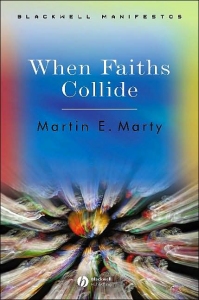
|
Posted February 17, 2005
Book: When Faiths Collide Author: Martin E. Marty Blackwell Publishing, Malden, MA, pp. 193 An Excerpt from the Jacket:
An Excerpt from the Book Where Does the Risk of Hospitality Lead? Theologies of pluralism are most satisfying to liberal thinkers in the various faiths, while popular versions of these color the interpretation of great numbers of moderate folks in each. There is great resistance to these as instruments through which bridging among faiths can occur if they are to ensure the integrity of the separate traditions and the stories by which they live. Realists can applaud the intellectual endeavors of theologians of pluralism, but they are also ready to recognize that for the foreseeable and probably long-term futures, the faith communities, for all their erosion, the buffeting they take in postmodernity, the indifference that gnaws at them, and the subtle syncretisms through which they adapt to the world around them, are too satisfying, too rewarding to millions who make them up, for any of them to be ready to be written off like Toynbee’s “fossilized” Jews, or merged by synthesizers. If the realist vision prevails, some might ask why put so much energy into risking hospitality, welcoming the stranger, and starting the conversation. The realist also knows how difficult and important that start is. Whoever deals with profound divisions, warring religious groups, and estranged parties who have become entrenched, has to treat the opening of the door as almost miraculous. As for the need for miracles at beginnings, a cherished story is a reminder. Paul Elmen tells it: When Cardinal de Polignac told Madame du Deffand taht the martyr St. Denis, the first Bishop of Paris, had walked a hundred miles carrying his head in his hand, Madame du Deffand correctly observed, “In such a promenade it is the first step that is difficult.” Lacking faith in miracles of such as sort need not breed a skepticism about the possibility of good things happening in the name of religious encounters. We have concentrated on engagement across the lines of religious factions and between faith communities, since restoring old ties or effecting new ones is so difficult and yet potentially so rewarding. To get French Muslims and French secularists to begin to meet and hear each other, and to probe the myths and stories of the other, is difficult enough. To get African Anglican bishops and North American Episcopal bishops, united in ecclesiastical life but bitterly divided over the issue of homosexuality, to do the same may seem more difficult. We have not even undertaken analysis of the Arab — Israeli, often Muslim-Jewish conflict in the Middle East, since it falls beyond the scope of this endeavor. Mention of efforts to envision better ways in that final instance, however, suggests that it is not in place to give up in circumstances that look hopeless and seem to need a miracle. People of good will put energies into changing such situations, often in ways congruent with themes of “belongers” and “strangers” – think of the Land issue there; the need to move beyond tolerance to the risk of hospitality; the possibility that lies in myth and story both to divide and to unite. Thus Marc Gopin, in a daring book that some would regard as optimistic, advances the issue of shared myth and ritual in creative ways. From exploration of the uniting and dividing myth of Abraham that underlies the developments of both people and summarized: “This conflict reveals some basic ways in which mythic constructs and competing stories and rituals frame this conflict in very profound ways.”He goes on to insist that “an inseparability of religion and culture in this conflict . . .presents both challenges and opportunities.” The cultures are dynamic, not static. He calls for “a creative investigation and experimentation with the vast reservoir of Abrahamic uses of ritual to heal, to establish basic patterns suggesting civility, to transform broken relations, to mourn, to repent, to end war, and to make ‘peace”: We must bring the issues of peace and conflict into innovative spaces of human engagement, such as the street, the public space, an area that has been engaged historically by cultural and religious traditions but is utterly neglected by the abstractions of contemporary approaches to coexistence. The public space matters. The human face in the public space matter. The programs of Marc Gopin and other practical dreamers include second and third steps and more than those St. Denis took on his “most difficult” hundred mile walk. The problem with the St. Denis story is that the martyr’s head had been severed and life was gone. So long as the human face is welcomed in the public space, there is life. Faiths will continue to collide, but those individuals and groups that risk hospitality and promote engagement with the stranger, the different, the other, will contribute to a world in which measured hopes can survive and those who hope can guide. Table of Contents: 1. Religious Strangers as Menaces 2. “Belongers” versus strangers 3. When faith communities conflict 4. The pluralist polity 5. Living with a pluralist polity 6. The risk of hospitality 7. Theological integrity in response |
|
